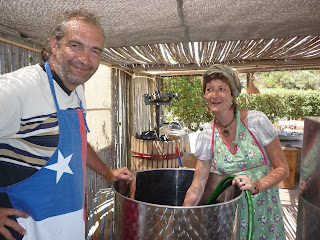
I was lucky enough to meet and spend some time with Stefano Vanzein in La Paz and learn about his medicinal plant project with the Leco communities, he is also happy to join us in our "Herborists sans frontiers" project.
Stefano finished his thesis on the medicinal plants of the Leco people of Bolivia nine years ago. Last year he decided he wanted to do something useful with this work and so started to put together an idea that has now become a reality.
The Leco people live in the gateway to the Amazonian rainforest and have a strong cultural knowledge of the local medicinal plants. However with the inevitable contact with the modern world, this rich and important knowledge, that has always been passed on orally is getting lost.
Stefano's project consists of the creation of a workbook on their local medicinal plants for Leco school children aged between 9 and 17 years old. The book identifies these plants with detailed sketches and includes both the tribal and local names of the plants, the scientific names are not included as they mean nothing to the local people. Indications of what part of the plant is used, preperation techniques, any eventual risks ( all this is in the local dialect and in Spanish) there will also be space for the children to add their own information, interviews with their elders, notes, drawings etc.
The book will also try to introduce ideas about protecting the local environement and the possible risks to be aware of etc, this will be done with phrases by famous people about ecology, information about seed collecting,the dangers of genetically modified plants and seeds and how to collect and grow plants without damaging nature with chemicals etc. Diet will also be looked at and how these local plants can be used for other things other than medicinal uses alone.
In order to complete this project Stefano spent 6 months in Bolivia last year and returned this year to finalise things. He has been working with 5 local communities ranging in size from 100 to 1000 people. His time has been spent mostly with the elder members of the communities as they have retained the precious knowledge that he is trying preserve. The plants he collects are identified at La Paz at the countries botanical resource centre, the team here are amazingly specialized, researchers work in the forest and then catalogue the informatiion. The Bolivian governement has agreed to the project and is going to make the workbook into the official text for the schools of the region, it will also be used as a model for other communities.
I am really pleased to have met Stefano and his non-profit making project and hope that with "herborists sans frontiers" this connection will continue.
Stefano finished his thesis on the medicinal plants of the Leco people of Bolivia nine years ago. Last year he decided he wanted to do something useful with this work and so started to put together an idea that has now become a reality.
The Leco people live in the gateway to the Amazonian rainforest and have a strong cultural knowledge of the local medicinal plants. However with the inevitable contact with the modern world, this rich and important knowledge, that has always been passed on orally is getting lost.
Stefano's project consists of the creation of a workbook on their local medicinal plants for Leco school children aged between 9 and 17 years old. The book identifies these plants with detailed sketches and includes both the tribal and local names of the plants, the scientific names are not included as they mean nothing to the local people. Indications of what part of the plant is used, preperation techniques, any eventual risks ( all this is in the local dialect and in Spanish) there will also be space for the children to add their own information, interviews with their elders, notes, drawings etc.
The book will also try to introduce ideas about protecting the local environement and the possible risks to be aware of etc, this will be done with phrases by famous people about ecology, information about seed collecting,the dangers of genetically modified plants and seeds and how to collect and grow plants without damaging nature with chemicals etc. Diet will also be looked at and how these local plants can be used for other things other than medicinal uses alone.
In order to complete this project Stefano spent 6 months in Bolivia last year and returned this year to finalise things. He has been working with 5 local communities ranging in size from 100 to 1000 people. His time has been spent mostly with the elder members of the communities as they have retained the precious knowledge that he is trying preserve. The plants he collects are identified at La Paz at the countries botanical resource centre, the team here are amazingly specialized, researchers work in the forest and then catalogue the informatiion. The Bolivian governement has agreed to the project and is going to make the workbook into the official text for the schools of the region, it will also be used as a model for other communities.
I am really pleased to have met Stefano and his non-profit making project and hope that with "herborists sans frontiers" this connection will continue.



















